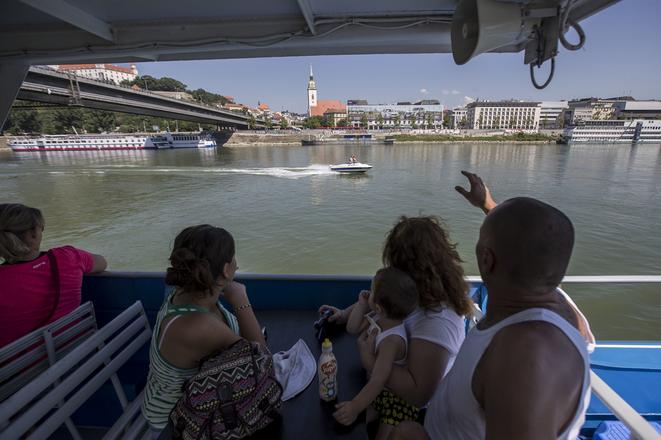Slovakia has only recently started to better harness its beauties to draw more tourists and the number of tourists spending their holidays in Slovakia increased by almost 19 percent during the first half of 2016. While the numbers keep increasing and creating new records, destination management organisations fear that less money allocated to them for promotion in the draft state budget for next year may reverse this positive trend.
“For us it is a bad sign because when tourism thrives and we are speaking about record numbers, the state is also profiting – in the form of taxes,” said Marek Harbuľák, president of the Association of Hotels and Restaurants (ZCR) as cited by the SITA newswire.
In the draft state budget for 2017 in the chapter of the Transport Ministry there is only €7.5 million allocated for tourism. This is a drop from the €11.5 million allocated for 2016. Harbuľák sees this money as the only active instrument of the state to support tourism. These are subsidies to support the promotion of Slovakia by destination management organisations.
“The reward to us for raising more money for the state is a reduction in their support,” Harbuľák told the TASR newswire, adding that from almost €5 billion spent by tourists for services in tourism in 2015 the state got €280-300 million in VAT and that this sector already employs 380.000 people.
Harbuľák believes that one year with reduced support for promotion is enough to lose in the highly competitive environment of tourism in Europe.
“We will not be visible to potential visitors and this will have not only an immediate consequence but it will drag us down for some years, as our experiences from previous years indicate,” said Harbuľák, adding that Slovakia cannot count automatically on the reputation of Slovakia as a safe country as there are more such in Europe
In 2016, district and regional destination management received support of €4.2 million when this was calculated from the number of accommodated visitors in 2014. As the year of 2015 was more successful than 2014, they had expected that in 2017 there would be more funds.
ZCR also points out that next year the activities of the Slovak Tourist Board (SACR) would have to be financed from the same budget and calls on the government to re-evaluate the allocation and increase this sum.
Zuzana Onufer, spokesperson of SACR, points out that negotiations about the state budget have not finished yet and that the sum for the support of tourism may still increase. She refused to specify what portion from the €7.5 million SACR should get next year.
Head of the Slovak Association of Travel Agencies (SACKA) Stanislav Macko noted that as the sum in question is still only a draft of the state budget, it could change significantly but he sees the current allocation as underrated while the consequence may be a drop in interest in Slovakia in the future.
Martin Macharík from the Association for Tourism in Banská Štiavnica sees the general usage of subsidies in tourism especially in terms of building infrastructure as quite unfortunate, when instead of using the money for building infrastructure that serves all, like educational and cyclo paths, it is used for the support of building of restaurants and hotels.
“Thus when tens and hundreds of millions of euros are used to support building accommodation facilities or restaurants and not for building infrastructure as educational and cyclo paths, the discussion about how much the state contributes to some leaflets is useless,” Macharík told The Slovak Spectator.
Tourism up in 2016
Slovakia is well on the way to breaking a record in the number of tourists visiting Slovakia. During the first half of 2016 almost 2.3 million tourists decided to spend their holiday in Slovakia. Compared with the same period in 2015 it is an increase of 18.9 percent, the Slovak Tourist Board (SACR) informed in early September based on data from the Slovak Statistics Office.
Both the number of domestic and foreign tourists increased. Year-on-year, the number of domestic visitors went up by 223,453, or 19.2 percent; while there were 136,133 more foreign tourists, an increase of 18.5 percent.
Economic analyst Jozef Orgonáš told the Hospodárske Noviny daily that numbers would have been even better if the number of tourists from Russia and the Ukraine had not dropped. On the other hand the numbers of visitors from Asian countries increased dramatically. Among top visitors are Austrians, Germans and Brits.
“These results have been impacted by several factors, for example the better quality and competitiveness of products offered, geo-political development in Europe, and the higher recognition of the brand Slovakia obtained through organising important international events, such as the Downhill skiing World Cup in Jasná, The European Figure Skating Championship in Bratislava and last but not least, the Slovak presidency in the Council of the EU,” CEO of SACR Igor Donoval said, as quoted by the SITA newswire.
Businesses active in tourism and market watchers also include the unfavourable security situation in sea resorts in their reasons for what makes from Slovakia a safe country, as well as better promotion of Slovakia abroad, better and more extensive services and the improved economic situation.
“Even though one could say that a holiday in the Tatras costs as much as a stay by the sea,” economic analyst Jozef Orgonáš told the Hospodárske Noviny daily. “The fact is that services have improved. There is finally some life in the Tatras in the evening even though not as much as tourists would like.”
Macharík of the Association for Tourism in Banská Štiavnica agrees that improvement in services, better tourism infrastructure as well as increasing competition is one of the factors behind more tourists in Slovakia.
“A holiday in Slovakia has not been such a traumatising experience as it used to be 15 years ago,” said Macharík.



 (source: sme)
(source: sme)